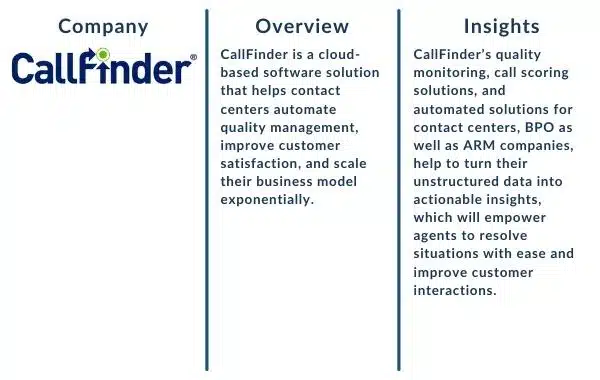Customer relationship Management (CRM): M&A Reaches New Record in 2021
By CAS January, 2022
M&A deal activity in 2021 reached a new record for the CRM industry, which generated 109 deals representing almost $28.5 billion in total deal value. Like the healthcare RCM industry, the CRM results were driven by a handful of billion dollar plus deals. However, CRM differed in one key aspect… the majority of its deal activity involved CRM companies that were focused on technology and software driven solutions. Notable deals of this type included:
- Zoom’s acquisition of Five9
- Thoma Bravo’s acquisition of Calabrio
- Brown Brothers Harriman Capital Partners’ acquisition of Noble Systems
However, there were also sizable CRM transactions involving service based businesses:
- Sitel Group’s acquisition of Sykes Enterprises (NASDAQ: SYKE)
- Teleperformance’s acquisition of Senture
- ChrysCapital’s acquisition of ResultsCX
CRM technology providers and omni channel servicing solutions companies supported by artificial intelligence/machine learning capabilities are driving the forefront of M&A activity. We anticipate this trend to continue into 2022.
Innovation at the Forefront
Big players in the CRM space are all focused on innovation as we continue into 2022. Whether it is migrating to omnichannel or implementing a new software solution centered on utilizing artificial intelligence and machine-learning, technology has become paramount. With labor shortages continuing, for companies to succeed, they will have to offer more flexible work conditions and higher pay to attract and retain talent. They will also have to leverage technology to automate more administrative tasks and have their workforce focused on higher level contributions that will require significant training and resources.
A. Contact Centers – The Future is Omnichannel
Omnichannel contact centers leverage integrated software solutions that streamline client service communications while updating available customer information and various communication channels in real-time. For example, a customer starts a social media chat conversation, but later opts to switch to a phone call as the conversation progresses, all without the customer having to answer repeated questions or reiterate their issue. This can all be done seamlessly allowing customers to choose their preferred method of communication and improving overall experience satisfaction.
This method of customer service is continuing to grow in popularity, becoming the new standard. Benefits include quicker resolution times, improved customer personalization, better retention rates, and remote workforce optimization, all resulting in a more consistent cross-channel experience. To remain competitive companies will look to leverage the big players in the omni channel industry, through their integrated 3rd-party communication and CRM tools.
B. Robot Usage Grows Exponentially
As advancements in artificial intelligence and machine learning continue to evolve, the use of robots and chat functionality has become much more prevalent. Improved customer experience is the number one focus, removing human voice from the equation and replacing it with chatbots that can field routine questions and inquiries. By taking the human element out, robots have been proven to avoid long talk times that often lead to complaints from customers.
Regulation in this area continues to evolve as consumer information and data privacy drive increased need for legislation. The 2019 Pallone-Thune TRACED Act, which took effect on July 1, 2021, included the STIR/SHAKEN framework which aims to reduce the amount of spoofing and help with customer identification issues. There is a lot of gray area to be worked through when it comes to defining how companies must “know your customer” especially when it comes to robocalling. “AI-driven reputational analytics are going to continue to play a key role in call delivery.”
Machines helping humans perform their work functions is nothing new, however the level of input machines can and will continue to provide is shifting. According to a recent Harvard Business Review article, human in the loop for exceptions (HITLFE) is the new technological focus, automating more of the human function. With this type of machine learning algorithm, humans’ roles become more of identifying exceptions, rather than making all the decisions. Utilizing this type of technology cuts down number of workers needed, reduces potential errors that can be made in the collection process and drives down costs overall.
C. Work From Home Shift
The work from home shift is here to stay and companies that can properly offer remote work and hybrid options to their employees will continue to thrive and attract the right workers, while others will not. Larger companies with scalable international footprints are the best positioned to handle this shift as they better offer large institutions the needed redundancy in this uncertain landscape.
Within the United States, laws and requirements for companies and employees continue to be riddled with uncertainty and inconsistencies. For example, Maryland, Minnesota, and Connecticut all enacted guidance allowing remote work to continue, yet other states like California passed a debt collection licensing act and a consumer financial protection law requiring all debt collectors to submit for licenses by December 31st of this year. As remote work continues to be a growing trend for most companies, more clarity will need to come around the rules and regulations that govern collectors and their ability to work from home.
D. The Convergence of Technology & Service Continues
Think about the last time you ordered food to be delivered. You likely completed the entire process through an app or website on your phone, including resolving any issues that came up throughout the process. Today people expect simple, streamlined, and efficient customer service that is 100% digital. This has increased companies’ focus on providing such solutions to their customers, reducing the number of actual people needed for support roles. Support chat functionality is the new norm, empowering chat bots and software solutions to handle incoming questions, issues, and orders with ease.
According to a recent Gartner report on key customer service trends to watch, emerging technologies such as artificial intelligence (AI), internet of things (IoT), and virtual reality (VR) as they continue to becoming go to solutions for handling case management, address growing customer demands, and managing a hybrid workforce. The report also cited the importance of providing digital self-service and utilizing valuable data analytics to better understand consumer behavior and needs.
E. Predictions for 2022
Technology continues to lead the changing dynamic in the CRM world, shifting workers responsibilities to a more strategic and problem-solving focus, and automating everything else using AI and machine learning. We expect larger companies to continue investing in innovative solutions that streamline their business processes, however security and regulations around these massive changes are still largely unknown. Protecting consumer data and adhering to new regulation demands will also be challenges that continue to affect this change.






